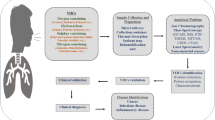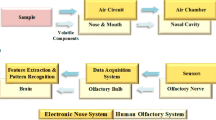Abstract
We evaluated whether a fingerprint, which consists of secretions from the fingertips, is a suitable biological sample for drug testing. A commercially available cold medicine containing ibuprofen, dihydrocodeine, chlorpheniramine, and methylephedrine was administered to healthy subjects. The subjects washed their hands with tap water and hand soap to remove the external contaminants, and then pressed a fingertip onto wet filter paper at fixed sampling times (from 2 h to 7 days). The analytes on the filter paper were dissolved in 25 % methanol–water, and a large volume (50 μl) of the extract was analyzed by liquid chromatography–tandem mass spectrometry. The relationship between the sampling times and the concentration of analytes in fingerprints was examined. The results were compared with drug concentrations in blood samples. Most of the drugs and their metabolites were detected from fingerprints at 7 days after drug administration. The fingerprint sample preparation is rapid (ca. 3 min) and simple, and the limits of detection were 0.1 pg/fingerprint for dihydrocodeine, chlorpheniramine, and methylephedrine. We demonstrate that drugs can be detected in fingerprints at later sampling times with more rapid and simpler sample preparation than in blood. The method should be applicable to drug testing in criminal investigations.




Similar content being viewed by others
References
Galton F (1892) Finger prints. Macmillan, London
Lee HC, Gaensslen R (2001) Advances in fingerprint technology. CRC Press, Boca Raton
Bush DM (2008) The US mandatory guidelines for federal workplace drug testing programs: current status and future considerations. Forensic Sci Int 174:111–119
Barnes AJ, Smith ML, Kacinko SL, Schwilke EW, Cone EJ, Moolchan ET, Huestis MA (2008) Excretion of methamphetamine and amphetamine in human sweat following controlled oral methamphetamine administration. Clin Chem 54:172–180
Rowell F, Hudson K, Seviour J (2009) Detection of drugs and their metabolites in dusted latent fingermarks by mass spectrometry. Analyst 134:701–707
Clemons K, Wiley R, Waverka K, Fox J, Dziekonski E, Verbeck GF (2013) Direct analyte-probed nanoextraction coupled to nanospray ionization-mass spectrometry of drug residues from latent fingerprints. J Forensic Sci 58:875–880
Ifa DR, Manicke NE, Dill AL, Cooks RG (2008) Latent fingerprint chemical imaging by mass spectrometry. Science 321(5890):805
Bradshaw R, Wolstenholme R, Blackledge RD, Clench MR, Ferguson LS, Francese S (2011) A novel matrix-assisted laser desorption/ionisation mass spectrometry imaging based methodology for the identification of sexual assault suspects. Rapid Commun Mass Spectrom 25:415–422
Goucher E, Kicman A, Smith N, Jickells S (2009) The detection and quantification of lorazepam and its 3-O-glucuronide in fingerprint deposits by LC–MS/MS. J Sep Sci 32:2266–2272
Ng PH, Walker S, Tahtouh M (2009) Detection of illicit substances in fingerprints by infrared spectral imaging. Anal Bioanal Chem 394:2039–2048
Hazarika P, Jickells SM, Russell DA (2009) Rapid detection of drug metabolites in latent fingermarks. Analyst 134:93–96
Kuwayama K, Tsujikawa K, Miyaguchi H, Kanamori T, Iwata YT, Inoue H (2013) Time-course measurements of caffeine and its metabolites extracted from fingertips after coffee intake: a preliminary study for the detection of drugs from fingerprints. Anal Bioanal Chem 405:3945–3952
Johnson RD, Botch-Jones SR (2013) The stability of four designer drugs: MDPV, mephedrone, BZP and TFMPP in three biological matrices under various storage conditions. J Anal Toxicol 37:51–55
Liu G, Ji QC, Jemal M, Tymiak AA, Arnold ME (2011) Approach to evaluating dried blood spot sample stability during drying process and discovery of a treated card to maintain analyte stability by rapid on-card pH modification. Anal Chem 83:9033–9038
Lee D, Milman G, Schwope DM, Barnes AJ, Gorelick DA, Huestis MA (2012) Cannabinoid stability in authentic oral fluid after controlled cannabis smoking. Clin Chem 58:1101–1109
Coulter C, Garnier M, Moore C (2012) Analysis of tetrahydrocannabinol and its metabolite, 11-nor-Δ9-tetrahydrocannabinol-9-carboxylic acid, in oral fluid using liquid chromatography with tandem mass spectrometry. J Anal Toxicol 36:413–417
Momoh P, Fandino A, Aisawa E, Schlabach T, Miller K, Stafford G (2010) Technical overview: iFunnel technology for enhanced sensitivity in tandem LC/MS. Agilent Technologies, Santa Clara
Romanelli A, Olson L, Biesenthal T, Ghobarah H (2012) Technical note: the AB SCIEX Triple Quad™ 6500 system for bioanalysis—a new level of sensitivity. AB SCIEX, Framingham
Jenkins TJ (2010) FPRW seminar: advanced MS technologies for residue screening and quantitation. Waters, Manchester
Watanabe J, Hike H, Yasumoto M, Horie S, Bando Y (2008) Scientific posters: evaluation of column retentivity with large injection volume for high sensitive and high-throughput LC–MS/MS quantitative analysis. Imtakt, Kyoto
Clemons K, Wiley R, Waverka K, Fox J, Dziekonski E, Verbeck GF (2013) Direct analyte-probed nanoextraction coupled to nanospray ionization-mass spectrometry of drug residues from latent fingerprints. J Forensic Sci 58:875–880
Bradshaw R, Rao W, Wolstenholme R, Clench MR, Bleay S, Francese S (2012) Separation of overlapping fingermarks by matrix assisted laser desorption ionisation mass spectrometry imaging. Forensic Sci Int 222:318–326
Hazarika P, Jickells SM, Wolff K, Russell DA (2010) Multiplexed detection of metabolites of narcotic drugs from a single latent fingermark. Anal Chem 82:9150–9154
Gilchrist E, Smith N, Barron L (2012) Probing gunshot residue, sweat and latent human fingerprints with capillary-scale ion chromatography and suppressed conductivity detection. Analyst 137:1576–1583
Benton M, Chua MJ, Gu F, Rowell F, Ma J (2010) Environmental nicotine contamination in latent fingermarks from smoker contacts and passive smoking. Forensic Sci Int 200:28–34
Acknowledgments
This work was supported in part by a Grant-in-Aid for Young Scientists (B) (24790649) from the Japan Society for the Promotion of Science.
Author information
Authors and Affiliations
Corresponding author
Rights and permissions
About this article
Cite this article
Kuwayama, K., Yamamuro, T., Tsujikawa, K. et al. Time-course measurements of drugs and metabolites transferred from fingertips after drug administration: usefulness of fingerprints for drug testing. Forensic Toxicol 32, 235–242 (2014). https://doi.org/10.1007/s11419-014-0228-7
Received:
Accepted:
Published:
Issue Date:
DOI: https://doi.org/10.1007/s11419-014-0228-7




